During the height of 90s-era PC role-playing, Interplay with developers like Bioware made some of the best RPGs out there. Eventually, thanks to the all-consuming juggernaut that was Diablo, Baldur’s Gate: Dark Alliance branched out to become a more multiplayer action-focused gaming experience, and it did so with mixed results.
Years later, the Dark Alliance name has returned, much like a pesky evil wizard, to bring D&D back into the video gaming fold.
Dungeons & Dragons Dark Alliance Review: Going for the Gauntlet
Dark Alliance isn’t a role-playing game, though it certainly has RPG-like elements. You pick from one of four pre-set characters, and long-time fans of D&D lore might recognize the cast.
Drizzt Do’Urden, a Drow rogue with a variety of quick strikes and backstabbing, is certainly the most famous D&D character here. Catti-brie is a human archer and plays a more support-focused role. Wulfgar and Bruenor Battlehammer are both heavy fighters best at rushing enemies and smashing them to bits.
So, in class terms, there’s a fighter, rogue, barbarian, and ranger. It’s not an ideal line-up for variety. Magic spells aren’t a focus and the combat system is very combo-base, definitely making Dark Alliance feel much more arcade-like than RPG-like.
That’s not necessarily bad, of course. As your character builds up and gains ranks, they get more advanced combos and moves, totaling about 50 distinct moves for each.
Their character sheets and stats have been adjusted for the action progression of Dark Alliance as well. The usual D&D stats like strength, intelligence, wisdom, dexterity, etc. are all here, but all of them start incredibly low (such as around 5 or 6, for example) and each level earned gives you a point or two to increase an individual stat of your choosing.

Overall, the combat and skill trees are workable if not outstanding. The pacing of combat is a little jerky, and you can’t interrupt your moves to block. There are team combo moves and team boosts, but the action feels fairly basic overall. This is especially compounded by a weird lack of precision aiming and overall questionable hit detection.
In our hours playing, there was no indication of anything as basic as headshots (or any other body part). You either hit the thing in question or not, and damage is calculated in the background (presumably in some D&D stat-fashion) that seems more concerned with range than if it was a critical hit. It never seemed to matter where on an enemy you aimed, which is especially noticeable when playing as an archer.
Catti-brie’s shots consist of a lighter attack and heavy attack, both of which can be charged up. Her heavy attack will hit multiple enemies at once and generally do more damage, but even when using the targeting lock-on mechanic, it seemed mostly random which enemies (and how many) would get hit.
Damage also appears to be based on her range. In one spot she might only do 31 points of damage a shot, but move her a few yards forward and that same shot might inflict 300 points. She’s also incapable of shooting through any kind of gap or obstacle while standing near them, like large gaps between boarded-up walls or, perplexingly, over waist-high rope barriers on a bridge.
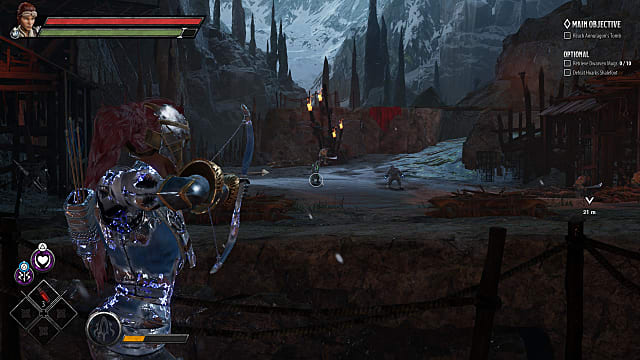
These idiosyncrasies are less noticeable with the other three close-combat characters, but there are other issues as well.
The movement physics feel a little off, so jumping and dodging come off as floaty and unresponsive. Worse is the overall camera and targeting. Locking on to an enemy is simply unreliable. When used, the third-person viewpoint zooms in much closer to your character than in games like Diablo or even the original Dark Alliance, and the camera simply has trouble not getting in the way.
This leads to mishaps like getting stuck on invisible level architecture in the thick of battle, falling off ledges, and just generally not being to get a decent view of the action. There are times when the game zooms in so close to your character that they actually block your view entirely. Not ideal for action-based combat.
The level design also tends to include quite a bit of platformer-style jumping, which frequently feels at odds with the rest of gameplay and clumsy physics.
There are a variety of other smaller issues. At times, the levels have sections where not much happens, which is especially problematic for multiplayer, and there are minor bugs here and there.
The biggest and most glaring issue is the enemy AI. Or lack thereof. It’s hard to say if the enemies are outfight broken or they just used the absolute barebones basic enemy behavior possible in the Unreal engine, but wow, these monsters are absurdly dumb.
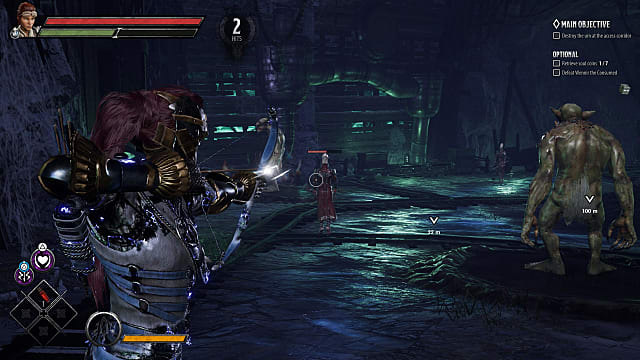
Monsters only notice and attack you within a very short range inside their very specific room or area. Attacking them outside that range (particularly from above) causes no reaction whatsoever. You can decimate a whole group of goblins from afar (usually with the archer), for instance, and they’ll never once bother to notice they’re being killed. It doesn’t even stop their canned conversations.
Rush your enemies and they’ll charge back, but just move slightly out of their designated area and the whole group will just turn around and give up like nothing happened. Sure, this is cheap, lame, and really poorly done, but on the other hand, it’s hilarious to watch and exploit. The humor also amps up thanks to some surprisingly funny dialogue (we get to hear a lot about the preparation and robust taste of dwarves, the finer points of collecting toes, and all kinds of bitching about the various other kinds of monsters).
These flaws might not seem quite so obvious in a full online game as when playing solo, but it still makes the action feel universally mindless.
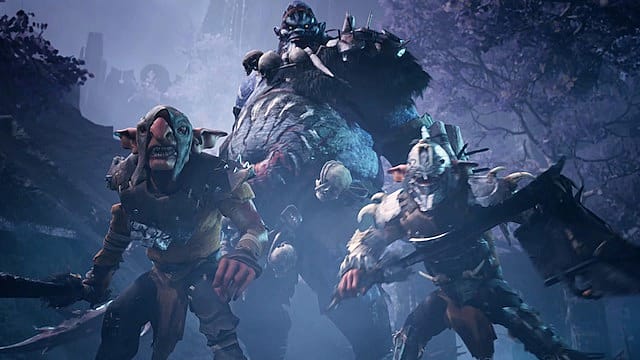
There are bright points in Dark Alliance. This hack and slash trip through Icewind Dale to stop a sentient crystal shard hilariously named “Crenshinibon,” (which sounds like it goes great with your morning coffee) looks excellent.
The monsters are detailed and animated (complete with some questionably funny physical taunts), even if they tend to look like they wandered straight off the set of a Lord of the Rings movie. The levels are sharp, detailed, and frequently lovely to behold with atmospheric lighting and effects.
While the overall graphic quality is excellent (and there really is some impressive-looking architecture here), frame rate issues popped up regularly during our time with it. On the PS5, the game hates flags moving at more than a few frames a second, and, at times, in-game animations would stumble for a second or two.
The soundtrack is quite good, especially the dramatic scoring. The voice acting got old fast, since you end up hearing the same sound bites a lot. Also, based on the vigorously athletic groans and moans she makes while unleashing arrow-laden hell on her enemies, one can only assume that Catti-brie is really enthusiastically (and weirdly) into archery.

The actual map design is quite good on the whole. The game has a noteworthy focus on giving players treasure-filled incentives to comb an entire level. Secret bits of treasure and lore abound, making it entertaining to just explore every potential path.
Currently, multiplayer is limited to online-only, but an update later this year should add split-screen. Players can either host a public or private game to take on the seven or so three-act chapters of the story. There’s somewhere between 15 to 30 hours of playtime, depending on if you’re just blasting through the story or trying to max your characters out and find every secret.
Finding and collecting tons of loot is a big part of the game. Aside from treasure and various (and confusingly rated crystals that also act as currency for upgrades), there’s armor, weapons, and other items up for grabs in chests and from fallen enemies.
Strangely, all that loot can only be equipped between levels. There’s a shop in the adventurer’s hub to sell unwanted gear and upgrade items and a loot chest that gives you bonus gear after a mission.
Dungeons & Dragons Dark Alliance Review — The Bottom Line
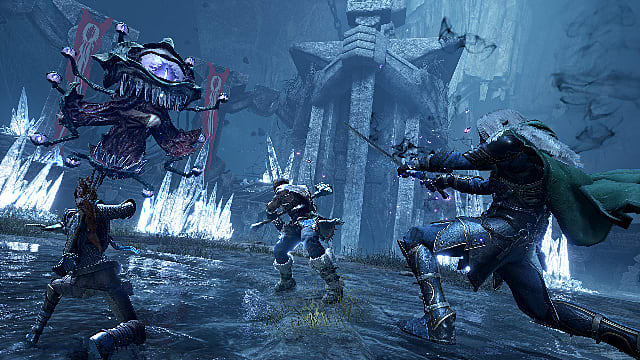
Pros
- Looks great with some really good level architecture and well-detailed characters
- Four-player adventuring helps lessen some of the other flaws
- Lots of loot to gather and monsters to kill
- Solid story and cinematic sequences
Cons
- Terrible enemy AI
- Glitchy
- Limited character selection
- Very questionable camera and targeting mechanics
Dungeons & Dragons Dark Alliance is not, by any means, a good game in the traditional sense, but still proves that multiplayer and great visuals can go a long way to making something fun anyway.
In the same way that a bad B-movie is still entertaining, Dark Alliance somehow feels a bit more charming because of some of its glaringly bad AI and design issues.
[Note: Tuque Games provided the copy of Dungeons & Dragons: Dark Alliance used for this review.]

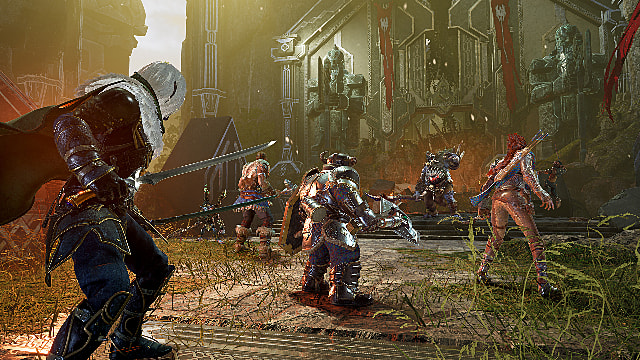





Published: Jun 21, 2021 08:21 pm